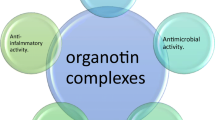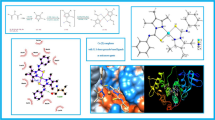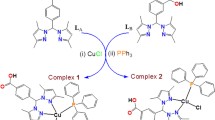Abstract
Extensive research is being devoted to the design and development of non-covalently DNA-binding drugs to overcome the side effects of covalently bonding platinum-based drugs. Moreover, several other factors determine the ability of a metal complex to become a successful bio-active agent. This short review highlights some of the features of copper(II) carboxylates which affect their ability to act as therapeutic agents in general and DNA-binding agents in specific.







Similar content being viewed by others
References
Addison AW, Rao TN, Reedijk R, van Rijn J, Verschoor GC (1984) Synthesis, structure, and spectroscopic properties of copper(II) compounds containing nitrogen–sulphur donor ligands; the crystal and molecular structure of aqua[1,7-bis(N-methylbenzimidazol-2′-yl)-2,6-dithiaheptane]copper(II) perchlorate. J Chem Soc Dalton Trans 7:1349–1356
Agotegaraya MA, Dennehy M, Boeris MA, Grela MA, Burrow RA, Quinzani OV (2012) Therapeutic properties, SOD and catecholase mimetic activities of novel ternary copper(II) complexes of the anti-inflammatory drug fenoprofen with imidazole and caffeine, Polyhedron 34:74–83
Agterberg FPW, Kluit HAJP, Driessen WL et al (1997) Dinuclear paddle-wheel copper (II) Carboxylates in the catalytic oxidation of carboxylic acids. Unusual polymeric chains found in the single-crystal X-ray structures of [Tetrakis (μ-1-phenylcyclopropane-1-carboxylato-O, O’) bis (ethanol-O) dicopper (II)] and catena-Poly [[bis (μ-diphenylacetato-O: O’) dicopper](μ3-diphenylacetato-1-O: 2-O’: 1’-O’)(μ3-diphenylacetato-1-O: 2-O’: 2’-O’)]. Inorg Chem 36:4321–4328
Arnaudeau C, Tenorio-Miranda E, Jenssen D, Helleday T (2000) Inhibition of DNA synthesis is a potent mechanism by which cytostatic drugs induce homologous recombination in mammalian cells. Mutat Res 461:221–228
Arnold A, Limberg C, Metzinger R (2012) Dinuclear paddle-wheel copper(II) carboxylates in the catalytic oxidation of carboxylic acids. Unusual polymeric chains found in the single-crystal X-ray structures of [Tetrakis(μ-1-phenylcyclopropane-1-carboxylato-O,O′)bis(ethanol-O)dicopper(II)] and catena-Poly[[bis(μ-diphenylacetato-O:O′)dicopper](μ3-diphenylacetato-1-O:2-O′:1′-O′)-(μ3-diphenylacetato-1-O:2-O′:2′-O′)]. Inorg Chem 51:12210–12217
Barve A, Kumbhar A, Bhat M, Joshi B, Butcher R, Sonawane U, Joshi R (2009) Mixed-ligand copper(II) maltolate complexes: synthesis, characterization, DNA binding and cleavage, and cytotoxicity. Inorg Chem 48:9120–9132
Burrows AD, Mahon MF, Raithby PR et al (2012) The effect of carboxylate and N,N′-ditopic ligand lengths on the structures of copper and zinc coordination polymers. Cryst Eng Comm 14:3658–3666
Chen J-X, Lin W-E, Chen M-Z et al (2012) Synthesis, characterization and potent DNA-cleaving activity of copper(II)-complexed berberine carboxylate. Bioorg Med Chem Lett 22:7056–7059
Chikira M, Ng CH, Palaniandavar M (2015) Interaction of DNA with simple and mixed ligand Copper(II) Complexes of 1,10-Phenanthrolines as studied by DNA-Fiber EPR spectroscopy. Int J Mol Sci 16:22754–22780
de Miranda JL, Felcman J, Herbst MH, Vugman NV (2008) Magnetic coupling detected by EPR in a paddle-wheel copper(II) complex of the amino acid guanidinoacetic acid. Inorg Chem Commun 11:655–658
Deng Z-P, Huo L-H, Li M-S, Zhang LW, Zhu Z-B, Zhao H, Gao S (2011) Syntheses, structures, and luminescent properties of silver(I) complexes constructed from ortho-hydroxyl arenesulfonic acids. Cryst Growth Des 11:3090–3100
Dey R, Bhattacharya B, Colacio E, Ghoshal D (2013) Fabrication of metal–organic hybrid architectures using bridging diphenyl phosphate: syntheses, characterization, magnetic properties and the effect of weak interactions on their crystal packing. Dalton Trans 42:2016–2094
Dhar S, Reddy PAN, Chakravarty AR (2004) Intramolecular nucleophilic activation promoting efficient hydrolytic cleavage of DNA by (aqua)bis(dipyridoquinoxaline)copper(II) complex. Dalton Trans 5:697–698
Domínguez-Martín A, Choquesillo-Lazarte D et al (2013) From 7-azaindole to adenine: molecular recognition aspects on mixed-ligand Cu(II) complexes with deaza-adenine ligands. Dalton Trans 42:6119–6130
Drabina P, Funk P, Ruzicka A, Moncol J, Sedlák M (2012) The structures of cobalt(II) and copper(II) complexes derived from 6-(4,5-dihydro-1H-imidazol-5-on-2-yl)pyridine-2-carboxylic acid. Polyhedron 34:31–40
Du M, Li C, Wu J, Guo J, Wang G (2011) Destruction and reconstruction of the robust [Cu2(OOCR)4] unit during crystal structure transformations between two coordination polymers. Chem Commun 47:8088–8090
Fedin MV, Zhilina EF, Chizhov DL et al (2013) Temperature-dependent zero-field splitting in copper(II) dimer studied by EPR. Dalton Trans 42:4513–4521
Filipovic N, Borrmann H, Todorovic T et al (2009) Copper(II) complexes of N-heteroaromatic hydrazones: synthesis, X-ray structure, magnetic behavior, and antibacterial activity. Inorg Chim Acta 362:1996–2000
Gil-Ramirez G, Benet-Buchholz J, Escudero-Adan EC, Ballester P (2007) Solid-state self-assembly of a calix[4]pyrrole−resorcinarene hybrid into a hexameric cage. J Am Chem Soc 129:3820–3821
Goswami TK, Gadadhar S, Karande AA, Chakravarty AR (2013) Photocytotoxic ferrocene-appended (L-tyrosine)-copper(II) complexes of phe‐nanthroline bases. Polyhedron 52:1287–1298
Gracia-Mora I, Ruiz-Ramirez L, Gomez-Ruiz C, Tinoco-Mndez M, Mtirquez-Quifiones A, Romero-De Lira L, Marin-Hernandez A, Madas-Rosales L, Bravo-Gomez ME (2001) Knight’s move in the periodic table, from copper to platinum, novel antitumor mixed chelate copper compounds, casiopeinas, evaluated by an in vitro human and murine cancer cell line panel. Metal Based Drugs 8:19–28
Graf N, Lippard SJ (2012) Redox activation of metal-based prodrugs as a strategy for drug delivery. Adv Drug Deliv Rev 64:993–1004
Halcrow MA (2013) Jahn–Teller distortions in transition metal compounds, and their importance in functional molecular and inorganic materials. Chem Soc Rev 42:1784–1795
Iqbal M, Ali S, Muhammad N, Sohail M (2013) Synthesis, crystal structures and electrochemical characterization of dinuclear paddlewheel copper(II) carboxylates. Polyhedron 57:83–93
Iqbal M, Ali S, Rehman Z-U, Muhammad N, Sohail M, Pandarinathan V (2014) Synthesis, crystal structure description, electrochemical, and DNA-binding studies of “paddlewheel” copper(II) carboxylate. J Coord Chem 67:1731–1745
Iqbal M, Ali S, Tahir MN, Muhammad N, Shah NA, Sohail M, Pandarinathan V (2015) Synthesis, crystal structure and electrochemical and DNA binding studies of oxygen bridged-copper(II) carboxylate. J Mol Struct 1093:135–143
Jalovy Z, Padelková Z, Jirásko R, Matyáš R, Holcapek M, Nemeca O, Novotná M, Mišková L (2012) Syntheses, crystal structures and properties of copper(II) complexes of 1-amidinoisourea and biguanide nitrates. Polyhedron 44:88–100
Jana A, Konar S, Das K et al (2012) Azide bridged dicopper(II), dicobalt(II) complexes and a rare double μ-chloride bridged ferromagnetic dicobalt(II) complex of a pyrazolyl-pyrimidine ligand: Synthesis, crystal structures, magnetic and DFT studies. Polyhedron 38:258–266
John EK, Green MA (1990) Structure-activity relationships for metal-labeled blood flow tracers: comparison of keto aldehyde bis(thiosemicarbazonato)copper(II) derivatives. J Med Chem 33:1764–1770
Joseph J, Nagashri K, Janaki GB (2012) Novel metal based anti-tuberculosis agent: Synthesis, characterization, catalytic and pharmacological activities of copper complexes. Eur J Med Chem 49:151–163
Juan H, Ping H, Wang Y et al (2008) Double-strand DNA cleavage by copper complexes of 2,2′-dipyridyl with guanidinium/ammonium pendants. Dalton Trans 24:3207–3214
Kellett A, Howe O, O’Connor M et al (2012) Radical-induced DNA damage by cytotoxic square-planar copper(II) complexes incorporating o-phthalate and 1,10-phenanthroline or 2,2′-dipyridyl. Free Rad Biol Med 53:564–576
Köberl M, Cokoja M, Hermann WA, Kühn FE (2011) From molecules to materials: Molecular paddle-wheel synthons of macromolecules, cage compounds and metal–organic frameworks. Dalton Trans 40:6834–6859
Kopylovich MN, Gajewska MJ, Mahmudov KT, Kirillova MV, Figiel PJ, da Silva MFCG, Gil-Hernandez B, Sanchiz J, Pombeiro AJL (2012) Copper(II) complexes with a new carboxylic-functionalized arylhydrazone of β-diketone as effective catalysts for acid-free oxidations. New J Chem 36:1646–1654
Kumagai H, Akita TM, Inoue K, Kurmoo M (2001) Hydrothermal synthesis and characterization of a new 3D-network containing the versatile cis,cis-cyclohexane-1,3,5-tricarboxylate. J Mater Chem 11:2146–2151
Kumar P, Gorai S, Santra MK, Mondal B, Manna D (2012) DNA binding, nuclease activity and cytotoxicity studies of Cu(II) complexes of tridentate ligands. Dalton Trans 41:7573–7581
Kumpf RA, Dougherty DA (1993) A mechanism for ion selectivity in potassium channels: computational studies of cation-pi interactions. Science 261:1708–1710
Li G, Liu N, Liu S, Zhang S (2008) Electrochemical biosensor based on the interaction between copper(II) complex with 4,5-diazafluorene-9-one and bromine ligands and deoxyribonucleic acid. Electrochim Acta 53:2870–2876
Li G-Y, Du K-J, Wang J-Q, Liang J-W, Kou J-F, Hou X-J, Ji L-N, Chao H (2013) Synthesis, crystal structure, DNA interaction and anticancer activity of tridentate copper(II) complexes. J Inorg Biochem 119:43–53
Lipinski L, Hopkins A (2004) Navigating chemical space for biology and medicine. Nature 432:855–861
Lopes PS, Paixão DA, de Paula FCS, Ferreira AMDC, Ellena J, Guilardi S, Pereira-Maia EC, Guerra W (2013) A new copper(II) complex with 2-thenoyltrifloroacetone and 2,2-bipyridine: crystal structure, spectral properties and cytotoxic activity. J Mol Struct 1034:84–88
Machura B, Switlicka A, Mrozinski J, Kalinska B, Kruszynski R (2013) Structural diversity and magnetic properties of thiocyanate copper(II) complexes. Polyhedron 52:1276–1286
Mahadevi AS, Sastry GN (2013) Cation−π interaction: its role and relevance in chemistry, biology and material science. Chem Rev 113:2100–2138
Maheshwari UP, Roy S, Dulk HD et al (2009) The square-planar cytotoxic [CuII(pyrimol)Cl] complex acts as an efficient DNA cleaver without reductant. J Am Chem Soc 128(2006):710–711
Majumder S, Fleck M, Lucas CR, Mohanta S (2012) A new tetraiminodiphenol macrocyclic ligand and its two dicopper(II) complexes: Syntheses, crystal structures, electrochemistry and magnetochemistry. J Mol Struct 1020:127–133
Marın-Hernandez A, Gracia-Mora I, Ruiz-Ramırez L, Moreno-Sanchez R (2003) Toxic effects of copper-based antineoplastic drugs (Casiopeinas®) on mitochondrial functions. Biochem Pharmacol 65:1979–1989
Massoud SS, Quan LL, Gatterer K, Albering JH, Fischer RC, Mautner FA (2012) Structural characterization of five-coordinate copper(II), nickel(II), and cobalt(II) thiocyanato complexes derived from bis(2-(3,5-dimethyl-1-pyrazolyl)ethyl)amine. Polyhedron 31:601–606
Milunovic MNM, Enyedy EA, Nagy NV et al (2012) L- and D-proline thiosemicarbazone conjugates: Coordination behavior in solution and the effect of copper(II) coordination on their antiproliferative activity. Inorg Chem 51:9309–9321
Mukherjee PS, Dalai S, Mostafa G, Zangrando E, Lu TH, Rogez G, Mallah T, Chaudhuri NR (2001) A three component fully interlocked 3-D network: crystal structure and magnetic properties. Chem Commun 15:1346–1347
Nakajima T, Seto K, Horikawa F, Shimizu I, Scheurer A, Kure B, Kajiwara T, Tanase T, Mikuriya M (2012) Wheel-shaped icosanuclear homo- and heterometallic complexes of NiII, CoII and CuII ions supported by unsymmetrical aminoalcohol ligands. Inorg Chem 51:12503–12510
Neuman NI, Franco VG, Ferroni FM et al (2012) Single crystal EPR of the mixed-ligand complex of copper(II) with L-glutamic acid and 1,10-Phenanthroline: A study on the narrowing of the hyperfine structure by exchange. J Phys Chem A 116:12314–12320
Ng CH, Kong KC, Von ST et al (2008) Dalton Trans 4:447–454
Nishikawa M, Nomoto K, Kume S, Nishihara H (2012) Reversible copper(II)/(I) electrochemical potential switching driven by visible light-induced coordinated ring rotation. J Am Chem Soc 134:10543–10553
Novotná R, Herchel R, Trávnícek Z (2012) Structurally varied Cu(II) complexes involving kinetin and its derivatives: synthesis, characterization and evaluation of SOD-mimic activity. Polyhedron 34:56–66
Okubo T, Anma H, Tanaka N, Himoto K, Seki S, Saeki A, Maekawa M, Kuroda-Sowa T (2013) Crystal structure and carrier transport properties of a new semiconducting 2D coordination polymer with a 3,5-dimethylpiperidine dithiocarbamate ligand. Chem Commun 49:4316–4318
Patel RN (2010) Structural, magnetic and spectroscopic characterization of two unusual end-on bis(μ-acetato/μ-nitrato) bridged copper(II) complexes with N′-[phenyl(pyridin-2-yl)methylidene]furan-2-carbohydrazide and (2E,4Z)-N,2-dimethylhepta-2,4,6-trienamide-1-phenyl-1-pyridin-2-ylmethanimine (1:1) as capping ligands. Inorg Chim Acta 363:3838–3846
Paterson BM, Donnelly PS (2011) Copper complexes of bis(thiosemicarbazones): From chemotherapeutics to diagnostic and therapeutic radiopharmaceuticals. Chem Soc Rev 40:3005–3018
Pogozhev D, Baudron SA, Rogez G, Hosseini MW (2013) From discrete tricyanovinylene appended 7-azaindole copper(II) paddlewheel to an infinite 1D network : synthesis, crystal structure and magnetic properties. Polyhedron 52:1329–1335
Prisecaru A, Devereux M, Barron N, McCann M, Colleran J, Casey A, McKee V, Kellett A (2012) Potent oxidative DNA cleavage by the di-copper cytotoxin: [Cu2(μ-terephthalate)-(1,10-phen)4]2. Chem Commun 48:6906–6908
Rajendiran V, Karthik R, Palaniandavar M et al (2007) Mixed-ligand copper(II)-phenolate complexes: effect of coligand on enhanced DNA and protein binding, DNA cleavage, and anticancer activity. Inorg Chem 46:8208–8221
Ramachandran E, Raja DS, Rath NP, Natarajan K (2013) Role of substitution at terminal nitrogen of 2-oxo-1,2-dihydroquinoline-3-carbaldehyde thiosemicarbazones on the coordination behavior and structure and biological properties of their palladium(II) complexes. Inorg Chem 52:1504–1514
Ramakrishnan S, Rajendiran V, Palaniandavar M, Periasamy VS, Srinag BS, Krishnamurthy H, Akbarsha MA (2009) Induction of cell death by ternary copper(ii) complexes of l-tyrosine and diimines: role of coligands on DNA binding and cleavage and anticancer activity. Inorg Chem 48:1309–1322
Reddy PVB, Rao KVR, Norenberg MD (2008) The mitochondrial permeability transition, and oxidative and nitrosative stress in the mechanism of copper toxicity in cultured neurons and astrocytes. Lab Investig 88:816–830
Reger DL, Pascui AE, Smith MD, Jezierska J, Ozarowski A (2012) Dinuclear complexes containing linear M−F−M [M = Mn(II), Fe(II), Co(II), Ni(II), Cu(II), Zn(II), Cd(II)] bridges: trends in structures, antiferromagnetic superexchange interactions, and spectroscopic properties. Inorg Chem 51:11820–11836
Reisner E, Arion VB, Keppler BK, Pombeiro AJL (2008) Electron-transfer activated metal-based anticancer drugs. Inorg Chim Acta 361:1569–1583
Ren R, Yang P, Zheng W, Hua Z (2000) A simple copper(II)−l-histidine system for efficient hydrolytic cleavage of DNA. Inorg Chem 39:5454–5463
Russell-Jones G, McTavish K, McEwan J (2011) Preliminary studies on the selective accumulation of vitamin-targeted polymers within tumors. J Drug Target 19:133–139
Selvakumar B, Rajendiran V, Maheshwari PU, Stoeckli-Evans H, Palaniandavar M (2006) Structures, spectra, and DNA-binding properties of mixed ligand copper(II) complexes of iminodiacetic acid: the novel role of diimine co-ligands on DNA conformation and hydrolytic and oxidative double strand DNA cleavage. J Inorg Biochem 100:316–330
Serment-Guerrero J, Cano-Sanchez P, Reyes-Perez E, Velazquez-Garcia F, Bravo-Gomez ME, Ruiz-Azuara L (2011) Genotoxicity of the copper antineoplastic coordination complexes casiopeinas®. Toxicol Vitr 25:1376–1384
Sgarabotto P, Bisceglie F, Pelosi G, Abdel-Rahman L (1999) X-ray crystal structures and characterization of copper(II)-2,2-bipyridyl derivatives of (4-amino)-hippuric acid and of L-proline. Polyhedron 18:2505–2510
Shao Y, Chen J (2009) A hydroxyl-bridged dinuclear copper complex having planar structure shows efficient DNA cleavage activity in aqueous solution. J Solut Chem 38:1357–1367
Shaughnessy KH (2009) Hydrophilic ligands and their application in aqueous-phase metal-catalyzed reactions. Chem Rev 109:643–710
Shen B, Shi P, Hou Y, Wan F, Gao D, Zhao B (2013) Structural diversity and magnetic properties of five copper–organic frameworks containing one-, two-, and three-types of organic ligands. Dalton Trans 42:3455–3463
Shimazaki Y, Stack TDP, Storr T (2009) Detailed evaluation of the geometric and electronic structures of one-electron oxidized group 10(Ni, Pd, and Pt)Metal(II)-(disalicylidene)diamine complexes. Inorg Chem 48:8383–8392
Sigman DS, Graham DR, Aurora VD, Stern AM (1979) Oxygen-dependent cleavage of DNA by the 1,10-phenanthroline. cuprous complex. Inhibition of Escherichia coli DNA polymerase I. J Biol Chem 254:12269–12272
Singh D, Baruah JB (2012) Metal(II) complexes derived from conformation flexible cyclic imide tethered carboxylic acids: syntheses, supramolecular structures, and molecular properties. Cryst Growth Des 12:2109–2121
Singh AP, Kaushik NK, Verma AK, Hundal G, Gupta R, Quinzani OV (2009) Synthesis, structure and biological activity of copper(II) complexes of 4-(2-pyridylmethyl)-1,7-dimethyl-1,4,7-triazonane-2,6-dione and 4-(2-pyridylethyl)-1,7-dimethyl-1,4,7-triazonane-2,6-dione. Eur J Med Chem 44:1607–1614
Smart P, Bejarano-Villafuerte A, Hendry RM, Brammer L (2013a) Persistent C–I∙∙∙π halogen-bonded layer motifs involving 4-iodobenzoate paddlewheel units, Cu2(4-Ibz)4(L)2. Cryst Eng Comm 15:3160–3167
Smart P, Bejarano-Villafuerte A, Brammer L (2013b) Coordination chemistry meets halogen bonding and hydrogen bonding: building networks from 3-iodobenzoate paddlewheel units [Cu2(3-Ibz)4(L)2]. Cryst. Eng. Comm 15:3151–3159
Smith AL, Hardcastle KI, Soper JD (2010) Redox-active ligand-mediated oxidative addition and reductive elimination at square planar cobalt(III): multielectron reactions for cross-coupling. J Am Chem Soc 132:14358–14360
Song Y-F, Kitson PJ, Long D-L, Parenty ADC, Thatcher RJ, Cronin L (2008) Supramolecular self-assembly and anion-dependence of copper(II) complexes with cationic dihydro-imidazo phenanthridinium (DIP)-containing ligands. Cryst Eng Comm 10:1243–1251
Stute S, Götzke L, Meyer D, Merroun ML, Rapta P, Kataeva O, Seichter W, Gloe K, Dunsch L, Gloe K (2013) Molecular structure, UV/Vis spectra, and cyclic voltammo-grams of Mn(II), Co(II), and Zn(II) 5,10,15,20-tetraphenyl-21-oxaporphyrins. Inorg Chem 52:1515–1524
Suntharalingam K, Hunt DJ, Duarte AA, White AJP, Mann DJ, Vilar R (2012) A tri-copper(II) complex displaying dna-cleaving properties and antiproliferative activity against cancer cells. Chem Eur J 18:15133–15141
Takaichi J, Ohkubo K, Sugimoto H, Nakano M, Usa D, Maekawa H, Fujieda N, Nishiwaki N, Seki S, Fukuzumi S, Itoh S (2013) Copper complexes of the non-innocent β-diketiminate ligand containing phenol groups. Dalton Trans 42:2438–2444
Tapley A, Vaccarello D, Hedges J, Jia F, Love DA, Ding Z (2013) Preparation and characterization of CuInS2 nanocrystals for photovoltaic materials. Phys Chem Chem Phys 15:1431–1436
Thorseth MA, Letko CS, Tse ECM, Rauchfuss TB, Gewirth AA (2013) Ligand effects on the overpotential for dioxygen reduction by tris(2-pyridylmethyl)amine derivatives. Inorg Chem 52:628–634
Urquiola C, Gambino D, Cabrera et al (2008) New copper-based complexes with quinoxalineN1, N4-dioxide derivatives, potential antitumoral agents. J Inorg Biochem 102:119–126
van Rijt SH, Kostrhunova H, Brabec V, Sadler PJ (2011) Functionalization of osmium arene anticancer complexes with (poly)arginine: effect on cellular uptake, internalization, and cytotoxicity. Bioconjug Chem 22:218–226
Wang LD, Zheng K, Li YT, Wu ZY, Yan CW (2013) Synthesis and crystal structure of a new copper(II) complex with N,N′-(4,4′-bithiazole-2,2′-diyl)diacetimidamide as ligand: Molecular docking, DNA-binding and cytotoxicity activity studies. J Mol Struct 1037:15–22
Wegner SV, Okesli A, Chen P, He C (2007) Design of an emission ratiometric biosensor from merr family proteins: a sensitive and selective sensor for Hg2+. J Am Chem Soc 129:3474–3475
Wei Z, Lu W, Jiang H-L, Zhou H-C (2013) A route to metal−organic frameworks through framework templating. Inorg Chem 52:1164–1166
Wein AN, Cordeiro R, Owens N et al (2009) Synthesis and characterization of Cu(II) paddlewheel complexes possessing fluorinated carboxylate ligands. J Fluor Chem 130:197–203
Wilson WR, Hay MP (2011) Targeting hypoxia in cancer therapy. Nat Rev Cancer 11:393–410
Windsor RE, Strauss SJ, Kallis C, Wood NE, Whelan JS (2012) Germline genetic polymorphisms may influence chemotherapy response and disease outcome in osteosarcoma. Cancer 118:1856–1867
Yan A, Tong ML, Ji L-N, Mao ZW (2006) Double-strand DNA cleavage by copper complexes of 2,2′-dipyridyl with electropositive pendants. Dalton Trans. 17:2066–2071
Yeong HY, Li Y, Kuhn FE, Voit B (2013) The role of solvent-ligated metal(II) complexes incorporating (floroalkoxy)aluminates as weakly coordinating anions in isobutylene polymerization. J Polym Sci Part A Polym Chem 51:158–167
Zheng Y-J, Li X-W, Li Y-T, Wu Z-Y, Yan C-W (2012) Synthesis and structure of new tetracopper(II) complexes bridged by 2-{N’-[2-(dimethylamino)ethyl]oxamido}benzoate: DNA-binding and anticancer activity. J Photochem Photobiol B Biol 114:27–37
Zhu Q, Shen C, Tan C, Sheng T, Hu S, Wu X (2012) A one-dimensional coordination polymer constructed from planar pentanuclear copper(II) clusters with a flexible tripodal ligand. Dalton Trans 41:9604–9606
Zivec P, Perdih F, Turel I, Giester G, Psomas G (2012) Different types of copper complexes with the quinolone antimicrobial drugs ofloxacin and norfloxacin: Structure, DNA- and albumin-binding. J Inorg Biochem 117:35–47
Author information
Authors and Affiliations
Corresponding authors
Ethics declarations
Conflict of interest
The authors declare that they have no conflict of interest.
Rights and permissions
About this article
Cite this article
Iqbal, M., Ali, S., Haider, A. et al. Structural Diversity, Electrochemical, and DNA-Binding Properties of Copper(II) Carboxylates. Iran J Sci Technol Trans Sci 42, 1859–1871 (2018). https://doi.org/10.1007/s40995-016-0141-5
Received:
Accepted:
Published:
Issue Date:
DOI: https://doi.org/10.1007/s40995-016-0141-5




